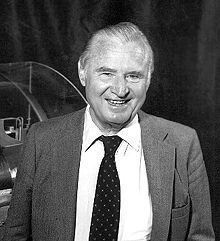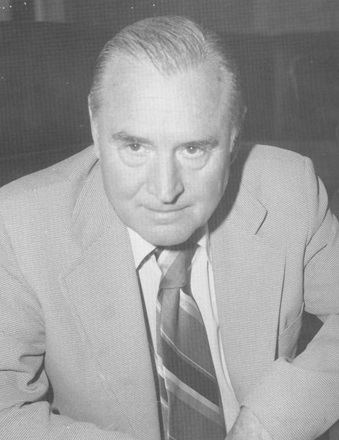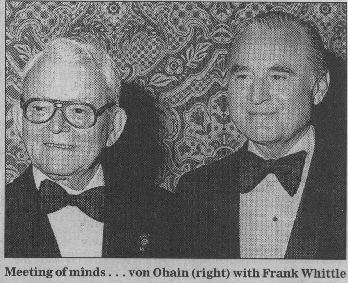Name Hans Ohain Role Physicist | Significant advance Jet engine | |
 | ||
Awards | ||
Education University of Gottingen | ||
The father of the jet engine hans von ohain
Hans Joachim Pabst von Ohain (14 December 1911 – 13 March 1998) was a German physicist, the designer of the first operational jet engine. His first design ran in March 1937, and it was one of his engines that powered the world's first flyable all-jet aircraft, the prototype of the Heinkel He 178 (He 178 V1) in late August 1939. In spite of these early successes, other German designs quickly eclipsed Ohain's, and none of his engine designs entered widespread production or operational use.
Contents
- The father of the jet engine hans von ohain
- Jet engine pioneers Frank Whittle UK Hans von Ohain Germany meet
- Early life and jet development
- Heinkel
- Post WWII
- Awards
- Death
- References

Ohain started to develop his first turbojet engine designs independently during the same period that Frank Whittle was working on his own similar designs in Britain, and their turbojet designs are said by some to be an example of simultaneous invention. However, Frank Whittle was already working on his design in the late 1920s and openly patented the design in 1930, a full seven years before Ohain's design ran. Ohain's first jet engine, the Heinkel HeS 1, ran successfully in April 1937, the same month that Whittle's first engine, the Power Jets WU First Model, also ran successfully. Ohain's jet engine was the first to fly operationally within the Heinkel He 178 aircraft in 1939, which was followed by Whittle's engine with-in the Gloster E.28/39 in 1941. Operational jet fighter aircraft from both Germany and Britain entered operational use virtually simultaneously in July, 1944. After the war the two men met and became friends.

Jet engine pioneers Frank Whittle UK & Hans von Ohain Germany meet
Early life and jet development

Born in Dessau, Germany, Ohain graduated PhD in Physics and Aerodynamics from the University of Göttingen, then one of the major centers for aeronautical research, having attended lectures by Ludwig Prandtl. In 1933, while still a student, he conceived what he called "an engine that did not require a propeller."

After receiving his degree in 1935, Ohain became the junior assistant of Robert Wichard Pohl, then director of the Physical Institute of the University. In 1936, while working for Pohl, Ohain registered a patent on his version of a jet engine, Process and Apparatus for Producing Airstreams for Propelling Airplanes. Unlike Frank Whittle's Power Jets WU design, Ohain's used a centrifugal compressor and turbine placed very close together, back to back, with the flame cans wrapped around the outside of the assembly.

While working at the University, Ohain often took his sports car to be serviced at a local garage, Bartles and Becker. Here he met an automotive mechanic, Max Hahn, and eventually arranged for him to build a model of his design for around 1,000 ℛℳ. The completed model was even larger in diameter than Whittle's fully working engine of 1937, although much shorter along its thrust axis. Ohain took the model to the University for testing but ran into serious problems with combustion stability. Often the fuel would not burn inside the flame cans and would be blown through the turbine, sending flames shooting out in the airstream and overheating the electric motor powering the compressor.
Heinkel

In February 1936, Pohl wrote to Ernst Heinkel, telling him about Ohain's design and its possibilities. Heinkel arranged a meeting between his engineers and Ohain, during which he argued that the current "garage engine" would never work, but that the concept upon which it was based was sound. The engineers were convinced, and in April Ohain and Hahn began working for Heinkel at the Marienehe airfield outside Rostock, in Warnemünde.
A study of the model's airflow resulted in several improvements over a two-month period. Encouraged by these findings, Ohain produced a new prototype that would run on hydrogen gas supplied by an external pressurised source. The resulting Heinkel-Strahltriebwerk 1 (HeS 1), German for Heinkel Jet Engine 1, was built by hand-picking some of the best machinists in the company, much to the chagrin of the shop-floor supervisors. Hahn, meanwhile, worked on the combustion problem, an area in which he had some experience.
The engine was extremely simple, made largely of sheet metal. Construction started late in the summer of 1936 and was completed in March 1937. Two weeks later the engine was running on hydrogen, but the high temperature exhaust led to considerable "burning" of the metal. The tests were otherwise successful, and in September the combustors were replaced and the engine was run on gasoline for the first time. Ohain had at last, albeit five months after Frank Whittle, working in parallel in England, run a self-contained turbojet. Running on gasoline proved to clog up the combustors, so Hahn designed a new version based on his soldering torch, which proved to work much better. Although the engine was never intended to be a flight-quality design, it proved beyond a doubt that the basic concept was workable, and Ohain had at last caught up with Whittle. With vastly more funding and industry support, Ohain would soon overtake Whittle and forge ahead.
While work on the HeS 1 continued, the Pohl-Ohain team had already moved on to the design of a flight-quality engine, the HeS 3. The major differences were the use of machined compressor and turbine stages, replacing the bent and folded sheet metal, and a re-arrangement of the layout to reduce the cross-sectional area of the engine as a whole by placing the flame cans in an extended gap between the compressor and turbine. The original design proved to have a turbine area that was simply too small to work efficiently, and increasing the size of the turbine meant the flame cans would no longer fit into the gap correctly.
A new design, the HeS 3b was proposed, which moved the flame cans out of the gap and modified their shape to allow the widest part of the cans to lie in front of the compressor's outer rim. In the HES 3b, compressed air was piped forward to the combustion chambers, and from there the hot air flowed rearward into the turbine inlet. While not as small as the original HeS 3 design, the 3b was nevertheless fairly compact. The 3b first ran in July 1939 (some references say in May), and was air-tested under the Heinkel He 118 dive bomber prototype. The original 3b engine soon burned out, but a second one was nearing completion at about the same time as a new test airframe, the Heinkel He 178, which first flew on 27 August 1939, the first jet-powered aircraft to fly by test pilot Erich Warsitz.
Work started immediately on larger versions, first the HeS 6 which was simply a larger HeS 3b, and then on a new design known as the HeS 8 which once again re-arranged the overall layout. The 8 separated the compressor and turbine, connecting them with a long shaft, placing a single annular combustion chamber between them, replacing the individual flame cans. It was intended to install the engine on the Heinkel He 280 fighter, but the airframe development progressed much more smoothly than the engine, and had to be used in gliding tests while work on the engine continued. A flight-quality HeS 8 was installed in late March 1941, followed by the first flight on 2 April. Three days later the aircraft was demonstrated for a party of Nazi and RLM officials, all of whom were impressed. Full development funds soon followed.
By this point there were a number of turbojet developments taking place in Germany. Heinkel was so impressed by the concept that he arranged the transfer to the project of Adolph Müller from Junkers, who was developing an axial compressor-powered design, renamed as the Heinkel HeS 30. Müller left Junkers after they purchased the Junkers Motoren company, who had their own project under way, which by this time was known as the Junkers Jumo 004. Meanwhile, BMW was making good progress with its own design, the BMW 003.
By early 1942 the HeS 8, officially the 109-001 (HeS 001), was still not progressing well. Meanwhile, Müller's HeS 30, officially the 109-006 (HeS 006), was developing much more quickly. Both engines were still some time from being ready for production, however, while the 003 and 004 appeared to be ready to go. In early 1942 the director of jet development at the RLM, Helmut Schelp, refused further funding for both designs, and ordered Heinkel to work on a new "pet project" of his own, eventually becoming the Heinkel HeS 011. Although this was the first of Schelp's "Class II" engines to start working well, production had still not started when the war ended. Work continued on the HeS 8 for some time, but it was eventually abandoned in the spring of 1943.
It has long been claimed that Ohain was unaware of Whittle's work. While in a very strict sense this may be true - (in that he was unaware of Whittle's experiments at Lutterworth where the RAF engineer ran the world's first jet engine in March 1937), nevertheless Ohain had thoroughly studied Whittle's various patents for gas turbine engines, as is normal professional practice for any academic working in a similar field, prior to filing his own patent which was registered in 1935, some five years after Whittle's. In his biography, Ohain frankly critiqued Whittle's design:
"When I saw Whittle's patent I was almost convinced that it had something to do with boundary layer suction combinations. It had a two-flow, dual entrance flow radial flow compressor that looked monstrous from an engine point of view. Its flow reversal looked to us to be an undesirable thing, but it turned out that it wasn't so bad after all though it gave some minor instability problems ... Our patent claims had to be narrowed in comparison to Whittle's because Whittle showed certain things." He then somewhat understandably justified their knowledge of Whittle's work by saying "We felt that it looked like a patent of an idea" "We thought that it was not seriously being worked on."
Post-WWII
In 1947, Ohain was brought to the United States by Operation Paperclip and went to work for the United States Air Force at Wright-Patterson Air Force Base. In 1956 he was made the Director of the Air Force Aeronautical Research Laboratory and by 1975 he was the Chief Scientist of the Aero Propulsion Laboratory there.
During his work at Wright-Patterson, Ohain continued his own personal work on various topics. In the early 1960s he did a fair amount of work on the design of gas core reactor rockets which would retain the nuclear fuel while allowing the working mass to be used as exhaust. The engineering needed for this role was also used for a variety of other "down to earth" purposes, including centrifuges and pumps. Ohain would later use the basic mass-flow techniques of these designs to create a fascinating jet engine with no moving parts, in which the airflow through the engine created a stable vortex that acted as the compressor and turbine.
This interest in mass-flow led Ohain to research magnetohydrodynamics (MHD) for power generation, noting that the hot gases from a coal-fired plant could be used to extract power from their speed when exiting the combustion chamber, remaining hot enough to then power a conventional steam turbine. Thus an MHD generator could extract further power from the coal, and lead to greater efficiencies. Unfortunately this design has proven difficult to build due to a lack of proper materials, namely high-temperature non-magnetic materials that are also able to withstand the chemically active exhaust. Ohain also investigated other power related concepts.
He also invented the idea of the "jet wing", in which air from the compressor of a jet engine is bled off to large "augmented" vents in the wings to provide lift for VTOL aircraft. A small amount of high-pressure air is blown into a venturi, which in turn sucks a much larger volume of air along with it, thus leading to "thrust augmentation". The concept was used in the Rockwell XFV-12 experimental aircraft, although the market interest in VTOL aircraft was short-lived. He participated in several other patents.
Ohain was the influence in shifting the mind of Paul Bevilaqua, one of his students at WP-AFB, from math to engineering, which later enabled Bevilaqua to invent the Rolls-Royce LiftSystem for the JSF F35B STOVL: "in school I learned how to move the pieces, and Hans taught me how to play chess". Ohain also showed Bevilaqua "what those TS-diagrams actually mean".
During his career, Ohain won many engineering and management awards, including (among others) the American Institute of Aeronautics and Astronautics (AIAA) Goddard Astronautics Award, the United States Air Force Exceptional Civilian Service Award, Systems Command Award for Exceptional Civilian Service, the Eugene M. Zuckert Management Award, the Air Force Special Achievement Award, and just before he retired, the Citation of Honor. In 1984–85, Ohain served as the Charles A. Lindbergh Chair in Aerospace History, a competitive senior fellowship at the National Air and Space Museum. In 1991 Ohain and Whittle were jointly awarded the Charles Stark Draper Prize for their work on turbojet engines. Ohain was elected a member of the U.S. National Academy of Engineering (NAE).
Awards
He retired from Wright-Patterson in 1979 and took up an associate professor position at the nearby University of Dayton. Ohain was awarded the Ludwig-Prandtl-Ring from the Deutsche Gesellschaft für Luft- und Raumfahrt (German Society for Aeronautics and Astronautics) for "outstanding contribution in the field of aerospace engineering" in 1992.
Death
Ohain later moved to Melbourne, Florida, with his wife Hanny, where he died in 1998, aged 86. He was survived by four children.
